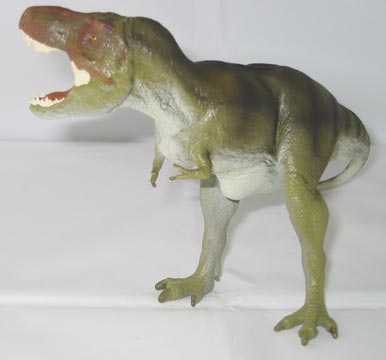Tyrannosaurus rex is still Scary say Chinese Youngsters
Young residents of Shanghai have been given a scare by a Tyrannosaurus rex that has taken up residence in the city. It may be rather surprising to find a T. rex in Shanghai, after all as far as palaeontologists know Tyrannosaurus rex lived in North America and it never got as far as eastern China. Asia was the domain of an equally fierce Tyrannosaur called Tarbosaurus “alarming reptile” a close cousin of the more famous T. rex.
However, a local company wanting to commemorate the opening of new premises commissioned a 5 metre long statue of T. rex and placed it on their rooftop. Local residents have objected claiming that the statue of T. rex in a typical pose (mouth open, showing huge teeth), frightens children.
Reluctantly, the company has agreed to remove the statue, but it has been given a stay of execution by the civic authorities, permitting T. rex to continue to look down on the locals – at least until the new premises are officially opened on August 8th.
After this date, either the statue will find a new home, or once again Tyrannosaurus rex will face extinction.
In reality, Tyrannosaurs could hardly be described as obvious candidates to have their features immortalised in a sculpture. These animals (like most super-predators today) lived short, violent lives. Tyrannosaurs would have been extremely unpleasant creatures to come across. As well as the prospect of being treated like a mid-morning snack, the smell from a recent kill would probably still hang around them and if you got close enough to smell the breath of a T. rex (something we would not recommend), the stench would be most unpleasant. T. rex most probably had a bacterial bite, meat would remain in the jaws and attract bacteria and other unpleasant pathogens. When T. rex bit into an animal, the bite may not prove fatal but the injection of all the nasty little bugs and diseases into the unfortunate animal could well have weakened it to the point where it would eventually collapse. Leaving the Tyrannosaur to simply follow its victim until it finally went down. Komodo dragons have a similar hunting strategy, although recent research has shown that these giant monitor lizards are actually venomous.
Evidence from the fossils indicate that Tyrannosaurus would carry a number of injuries and would most certainly have been scarred, so they would not have been pleasant to look at.
“Stan” the gracile T. rex discovered in 1992 shows evidence of a number of serious injuries, which would not have given this particular dinosaur much chance of winning a beauty pageant. For example, part of the postorbital and squamosal region of the skull (the back of the head) had been bitten off. Remarkably, as there are signs of healing revealed in close analysis of the fossil bones, “Stan” survived this traumatic injury.
Slightly concerning is that Stan was about 40 feet long and weighed in around 5 Tonnes. What kind of animal could have inflicted this sort of damage on a 40 foot Tyrannosaur?
Scientists know of only one animal capable of biting out chunks like this – another probably larger T. rex!
Evidence from their fossils, show that these animals lived short and violent lives. Fighting prey and fighting rival Tyrannosaurs possibly over food, territory and mates. For sure the big theropods may not have been much in the good looks stakes but they certainly still hold our fascination. Long after the likes of Marilyn Monroe have faded from our collective memory people will still queue to catch a glimpse into the lives of these ancient reptiles.
Typical model of Tyrannosaurus rex in aggressive pose:
A T. rex Dinosaur Model
Dinosaur Toys for Boys and Girls: Dinosaur and Prehistoric Animal Models.







Leave A Comment